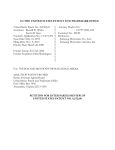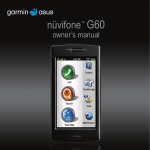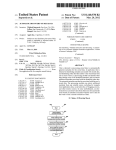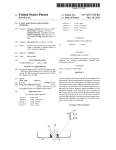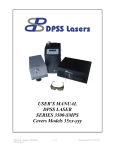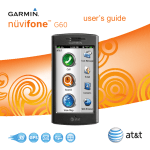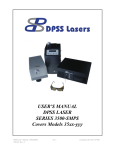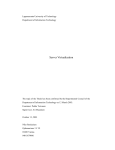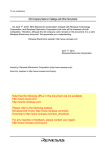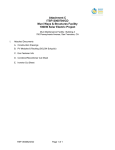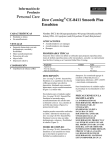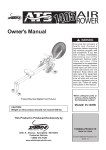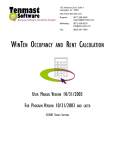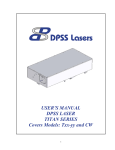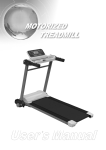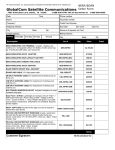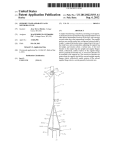Download IPR2015-00821 - Post
Transcript
Inter Partes Review United States Patent No. 8,532,641 IN THE UNITED STATES PATENT AND TRADEMARK OFFICE United States Patent No.: 8,532,641 Inventors: Russell W. White, Kevin R. Imes Formerly Application No.: 13/673,391 Issue Date: Sept. 10, 2013 Filing Date: Nov. 9, 2012 Priority Date: March 28, 2000 Former Group Art Unit: 2646 Former Examiner: Erika Washington § Attorney Docket No.: § 110797-0004-659 § Customer No. 28120 § Petitioners: § Samsung Electronics Co., Ltd.; § Samsung Electronics America, Inc. § § § § § § For: SYSTEM AND METHOD FOR MANAGING MEDIA MAIL STOP PATENT BOARD Patent Trial and Appeal Board United States Patent and Trademark Office Post Office Box 1450 Alexandria, Virginia 22313-1450 PETITION FOR INTER PARTES REVIEW OF UNITED STATES PATENT NO. 8,532,641 Inter Partes Review United States Patent No. 8,532,641 TABLE OF CONTENTS LIST OF EXHIBITS................................................................................................................ v I. INTRODUCTION....................................................................................................... 1 II. MANDATORY NOTICES UNDER 37 C.F.R. § 42.8 ......................................... 6 III. PETITIONERS HAVE STANDING ...................................................................... 7 IV. SUMMARY OF THE ‘641 PATENT ....................................................................... 9 A. Overview of the ‘641 Patent ............................................................................ 9 B. ‘641 Patent Prosecution History .................................................................... 11 V. THERE IS A REASONABLE LIKELIHOOD THAT PETITIONERS WILL PREVAIL WITH RESPECT TO AT LEAST ONE CLAIM OF THE ‘641 PATENT.................................................................. 12 A. Claim Construction Under 37 C.F.R. § 42.104(b)(3) ................................. 12 B. Level of Ordinary Skill in the Art & State of the Art ................................. 14 C. Ground 1: Obvious over Ito in view of Haartsen, Ushiroda, & Bork (Claims 1, 2, 5, 9); Ground 2: Obvious over Ito in view of Haartsen, Nokia, Ushiroda, & Bork (Claims 1-3, 5, 9, 10); Ground 3: Obvious over Ito in view of Haartsen, Rydbeck, Ushiroda, & Bork (Claims 1, 2, 5, 9); Ground 4: Obvious over Ito in view of Haartsen, Nokia, Rydbeck, Ushiroda, & Bork (Claims 1-3, 5, 9, 10); Ground 5: Obvious over Ito in view of Haartsen, Galensky, Ushiroda, & Bork (Claim 7); Ground 6: Obvious over Ito in view of Haartsen, Nokia, Galensky, Ushiroda, & Bork (Claims 6, 7); Ground 7: Obvious over Ito in view of Haartsen, Rydbeck, Galensky, Ushiroda, & Bork (Claim 7); Ground 8: Obvious over Ito in view of Haartsen, Nokia Rydbeck, Galensky, Ushiroda, & Bork (Claims 6, 7) ............................................................................................ 14 1. Overview of U.S. Pat. No. 6,990,334 (“Ito”)................................... 17 2. Overview of Nokia 9000/9000i Owner’s Manual (“Nokia”) ....... 18 3. Overview of U.S. Patent No. 6,212,403 (“Ushiroda”) ................... 18 4. Overview of U.S. Patent No. 6,633,932 (“Bork”) .......................... 19 5. Overview of U.S. Pat. No. 6,973,067 (“Haartsen”) ........................ 20 6. Overview of U.S. Pat. No. 7,123,936 (“Rydbeck”)......................... 21 7. Overview of U.S. Pat. No. 6,845,398 (“Galensky”)........................ 21 i Inter Partes Review United States Patent No. 8,532,641 Motivation to Combine Ito with Haartsen, Nokia, Ushiroda, Bork, Rydbeck, & Galensky ............................................................... 21 9. Claims 1-3, 5-7, 9 & 10 Are Obvious Over Grounds 1-8 ............. 29 CONCLUSION........................................................................................................... 47 8. VI. ii Inter Partes Review United States Patent No. 8,532,641 TABLE OF AUTHORITIES Page(s) CASES Dystar Textilfarben GMBH v. C.H. Patrick Co., 464 F.3d 1356, 1368 (Fed. Cir. 2006) ............................................................................. 27 In re Am. Acad. of Sci. Tech Ctr., 367 F.3d 1359 (Fed. Cir. 2004) ........................................................................................ 13 Kaiser Aluminum v. Constellium Rolled Prods. Ravenswood, LLC, Case IPR2014-01002, Paper 11 (Dec. 29, 2014) .......................................................... 16 KSR Int’l Co. v. Teleflex Inc., 550 U.S. 398 (2007) ................................................................................................... passim Liberty Mutual Insurance Co. v. Progressive Casualty Insurance Co., Case CBM2013-00009, Paper 10 (Mar. 28, 2013) ........................................................ 16 Nestle USA, Inc. v. Steuben Foods, Inc. Case IPR2014-01235, Paper 12 (Dec. 22, 2014) .......................................................... 16 Target Corp. v. Destination Maternity Corp., Case IPR2014-00508, Paper 28 (Feb. 12, 2015) .......................................................... 17 Target Corp. v. Destination Maternity Corp., Case IPR2014-00508, Paper 31 (Feb. 12, 2015) ..................................................... 8, 17 Target Corp. v. Destination Maternity Corp., Case IPR2014-00508, Paper 32 (Feb. 12, 2015) .......................................................... 17 STATUTES 35 U.S.C. § 102............................................................................................................................. passim § 103............................................................................................................................. passim § 112....................................................................................................................................... 1 §§ 311-319 ............................................................................................................................. 1 iii Inter Partes Review United States Patent No. 8,532,641 § 314..................................................................................................................................... 12 § 315................................................................................................................................ 8, 17 OTHER AUTHORITIES 37 C.F.R § 1.33.................................................................................................................................... 47 § 42 ......................................................................................................................................... 1 § 42.8...................................................................................................................................... 6 § 42.15 ................................................................................................................................. 47 § 42.22 ................................................................................................................................... 8 § 42.100 ........................................................................................................................ 13, 47 § 42.104 ...................................................................................................................... 7, 8, 12 § 42.105 ............................................................................................................................... 47 § 42.122 ................................................................................................................................. 7 § 325................................................................................................................................ 3, 16 MANUAL OF PATENT EXAMINING PROCEDURE § 2111 .................................................................................................................................. 13 iv Inter Partes Review United States Patent No. 8,532,641 LIST OF EXHIBITS Exhibit Ex. 1401 Ex. 1402 Ex. 1403 Ex. 1404 Ex. 1405 Ex. 1405A Ex. 1405B Ex. 1406 Ex. 1407 Ex. 1407A Ex. 1408 Ex. 1409 Ex. 1410 Ex. 1411 Ex. 1412 Ex. 1413 Ex. 1413A Ex. 1414 Description U.S. Patent No. 8,532,641 (“the ‘641 patent”) U.S. Patent No. 8,532,641 File History U.S. Patent No. 6,990,334 (“Ito”) Declaration of Harri Valio Declaration of Jari Toivanen Exhibit A to the Declaration of Jari Toivanen - User’s Manual for the Nokia 9000 Communicator, dated 1995, published by Nokia Mobile Phones. Exhibit B to the Declaration of Jari Toivanen - Owner’s Manual for the Nokia 9000i Communicator (“Nokia”), dated 1995-1997, published by Nokia Mobile Phones Ltd. U.S. Patent No. 6,973,067 (“Haartsen”) Declaration of Todd Michael Fenton Exhibit A to the Declaration of Todd Michael Fenton - “Bluetooth – the universal radio interface for ad hoc wireless connectivity”, J. Haartsen, Ericsson Review, The Telecommunications Technology Journal, No. 3, 1998 (“Haartsen Article”) U.S. Patent No. 7,123,936 (“Rydbeck”) U.S. Patent No. 6,845,398 (“Galensky”) U.S. Patent No. 6,633,932 (“Bork”) U.S. Patent No. 6,212,403 (“Ushiroda”) U.S. Patent No. 7,187,947 File History Declaration of Paul E. Berg Exhibit A to the Declaration of Paul E. Berg - Universal Serial Bus Specification, Revision 1.1, September 23, 1998, Compaq Computer Corporation, Intel Corporation, Microsoft Corporation, and NEC Corporation. U.S. Patent No. 7,953,390 File History Ex. 1415 May 20, 2014 Decision on Institution of Inter Partes Review in IPR2014-00209 (Inter Partes Review of U.S. Patent No. 7,953,390) Ex. 1416 May 20, 2014 Decision on Institution of Inter Partes Review in v Inter Partes Review United States Patent No. 8,532,641 Exhibit Description IPR2014-00212 (Inter Partes Review of U.S. Patent No. 7,953,390) Ex. 1417 June 12, 2014 Action Closing Prosecution in Reexamination Control Nos. 95/001,262 and 90/011,254 (Inter Partes and Ex Parte Reexaminations of U.S. Patent No. 7,187,947) Ex. 1418 June 30, 2014 Patent Trial and Appeal Board Decision, Appeal No. 2014-002024 in Reexamination Control No. 95/001,281 (Inter Partes Reexamination of U.S. Patent No. 7,634,228) Ex. 1419 Specification of the Bluetooth System v1.0 B, Vols. 1 & 2, 1999, Telefonaktiebolaget LM Ericsson, International Business Machines Corporation, Intel Corporation, Nokia Corporation, Toshiba Corporation. Ex. 1420 IBM Dictionary of Computing, Edited by George McDaniel, McGraw-Hill, Inc., 1994 January 30, 2015 Decision on Institution of Inter Partes Review in IPR2014-01181 (Inter Partes Review of U.S. Patent No. 8,532,641) January 30, 2015 Decision on Institution of Inter Partes Review in IPR2014-01182 (Inter Partes Review of U.S. Patent No. 8,532,641) January 30, 2015 Decision on Institution of Inter Partes Review in IPR2014-01184 (Inter Partes Review of U.S. Patent No. 8,532,641) Declaration of Dr. Schuyler Quackenbush Declaration of Hayan Yoon in Support of Petition for Inter Partes Review of United States Patent No. 8,532,641 Ex. 1421 Ex. 1422 Ex. 1423 Ex. 1424 Ex. 1425 vi Inter Partes Review United States Patent No. 8,532,641 I. INTRODUCTION Pursuant to 35 U.S.C. §§ 311-319 and 37 C.F.R. § 42, 1 Petitioners respectfully request inter partes review (“IPR”) of claims 1-3, 5-7, 9, and 10 (“Challenged Claims”) of U.S. Pat. No. 8,532,641 (“the ‘641 patent”) currently assigned to Affinity Labs of Texas, LLC (“Affinity”). The ‘641 patent is one of 14 patents that cite back to U.S. Pat. App. No. 09/537,812 (“the ‘812 application”) filed on March 28, 2000.2 These patents all share a common specification and generally relate to the delivery of Internet media content, such as “songs, on-line radio stations, on-line broadcasts, [or] streaming audio,” to a portable device. The portable device may be used to play the media content and may also be connected with another electronic device, such as a portable radio or vehicle audio system, so that the audio information may be communicated to the other 1 All sections cited in this Petition are from either 35 U.S.C. or 37 C.F.R. unless stated otherwise. All emphasis is added by Petitioners unless otherwise noted. 2 Petitioners submit in another IPR concurrently filed that Affinity is not entitled to the claimed priority date of March 28, 2000. For purposes of this Petition, however, Petitioners submit that the Challenged Claims are invalid over prior art that pre-dates March 28, 2000. Petitioners reserve the right to raise in an appropriate forum invalidity based on § 112, as well as the right to argue that the Challenged Claims are not entitled to the March 28, 2000 priority date based on other grounds. 1 Inter Partes Review United States Patent No. 8,532,641 electronic device. Petitioners previously filed a petition (IPR2014-01181) seeking inter partes review and judgment against claims 1-3 and 5-14 of the ‘641 patent based on combinations of Ito, Nokia, Haartsen, Rydbeck, and/or Galensky. On January 30, 2015, the Board granted the petition with respect to claims 8 and 11-14, finding that there was a reasonable likelihood that claims 8, 11, 13, and 14 are obvious over Ito in view of Haartsen, Nokia, and Rydbeck, and that claim 12 is obvious over Ito in view of Haartsen, Nokia, Rydbeck, and Galensky. Ex. 1421 at 15. The Board did not institute review as to ‘641 patent claims 1-3, 5-7, 9, and 10, however, concluding that the petition in IPR2014-01181 did not sufficiently identify support for obviousness in the combinations of Ito, Haartsen, Nokia Galensky and/or Rydbeck. Id. at 12. Specifically, the Board stated that, “[g]iven the wireless nature of Ito, Petitioner has not explained sufficiently why communicating information over Nokia’s physical interface would have been ‘advantageous’ or ‘convenient’ in Ito’s phone. . . . We are not persuaded, therefore, that Petitioner has presented sufficient articulated reasoning with rational underpinning to support combining Nokia’s physical interface with the specific wireless telephone device of Ito.” Id. at 11-12. While respectfully disagreeing with the Board’s decision not to institute a review of claims 1-3, 5-7, 9, and 10 in IPR2014-01181, Petitioners, rather than requesting reconsideration, now file this separate Petition requesting inter partes review of claims 1-3, 5-7, 9, and 10 as obvious based on the same primary prior art reference, 2 Inter Partes Review United States Patent No. 8,532,641 Ito, in view of Nokia, Haartsen, Rydbeck, and/or Galensky, and further in view of Ushiroda and Bork. These grounds — including new art (Ushiroda) not known to Petitioners before the filing of their original petition and located, instead, after the Board’s institution decision in IPR2014-01181 — raise new questions and address the concerns perceived by the Board in the earlier petition, with the benefit of the fuller explanation and consideration that a separate petition affords. Petitioners note that the Director, pursuant to Rule 325(c), may determine at the proper time that merger of the foregoing proceedings (in particular, IPR2014-01181) with this Petition may be appropriate, and as noted below, Petitioners are concurrently filing a motion for joinder of these proceedings. The Ushiroda and Bork references relied on in this Petition specifically address the Board’s concern with the Nokia reference that was expressed in IPR2014-1181. Ushiroda directly addresses the Board’s concern, as both Ito and Ushiroda describe Personal Handy Phone System (“PHS”) telephone devices, and Ushiroda discloses that its PHS telephone device has a physical interface for connecting to an external data terminal and for recharging the battery, in addition to wireless capability. Ex. 1411 at Fig. 1; 1:7-9; 2:51-56; 2:61-65; 3:10-12; 4:40-51. Bork also discloses a portable device such as a wireless telephone with a single physical interface for both data communication and recharging the battery, and explicitly discloses why it would have been advantageous to have a single physical interface on a wireless telephone, including the benefits of saving cost and travel space by eliminating the need for an 3 Inter Partes Review United States Patent No. 8,532,641 additional cable, eliminating the need for two dedicated power sources, and providing the ability to recharge a portable device from a second device when no other power source is available. See, e.g., Ex. 1410 at 2:54-63. Accordingly, Ushiroda and Bork explicitly address the Board’s concern that Petitioners had failed to demonstrate in IPR2014-01181 why a single physical interface for both data communication and recharging the battery would have been advantageous or convenient in the specific wireless telephone device of Ito. As set forth in this Petition, the supposed “invention” in each of the Challenged Claims was well-known and obvious prior to the claimed priority date of March 28, 2000. For example, the ‘641 patent claims require the following conventional features of a wireless phone that were well-known in the art long before March 28, 2000: a display, a housing, an enclosure, a rechargeable power supply, a physical interface for communicating data and receiving a recharging power, a memory, and the ability to alter an output of an audio signal when recognizing receipt of a phone call. Several of the references cited herein — including Ito, Nokia, Ushiroda, Bork, and Rydbeck — confirm that these conventional features of a wireless phone were well-known. In fact, these features were all found to be inherent in a wireless phone during prosecution of the ‘641 patent. Certain dependent claims also require such commonplace features as an email client, a voice-mail client, an Internet browser, a hands-free mode, and wirelessly receiving an upgrade for a software application, all of which were expressly disclosed, by, e.g., the cited Nokia 4 Inter Partes Review United States Patent No. 8,532,641 reference. The Challenged Claims also require the wireless phone to send information about available media content from the phone to a recipient device to generate a graphical menu comprising a selectable menu item. This feature was well-known in the art and is disclosed by at least the Ito reference, cited in this Petition. Dependent claims 6 and 7 require that the wireless telephone is capable of receiving data at two communication rates based at least partially upon an amount of data located in the buffer memory. This too was well-known in the art, as demonstrated by the Galensky reference cited herein. See, e.g., Ex. 1409 at 5:66-6:15, Ex. 1415. Indeed, during prosecution of the ‘390 patent (the grandparent to the ‘641 patent), the Examiner concluded that it would have been obvious to transmit data at two communication rates. Ex. 1414 at 500 (9/17/2010 OA at 6); see also Ex. 1416. Finally, claims 2, 3, 5, 9, and 10 require that the wireless communication module is compliant with a Bluetooth standard. The use of Bluetooth in the context of the ‘641 patent family has likewise been found by the PTO to have been obvious. See, e.g., Ex. 1417. In fact, companies including Ericsson, IBM, Intel, Nokia, and Toshiba had been working to develop Bluetooth technology long before March 2000. Ex. 1419. Each and every element of the Challenged Claims has been disclosed in the prior art and the Challenged Claims are nothing more than a routine and predictable combination of these well-known elements. Thus, Petitioners respectfully request that 5 Inter Partes Review United States Patent No. 8,532,641 the Board find that each of the Challenged Claims is invalid under 35 U.S.C. § 103. II. MANDATORY NOTICES UNDER 37 C.F.R. § 42.8 Notices Under 37 C.F.R. § 42.8(b)(1), (b)(3), & (b)(4): The Petitioners and real parties-in-interest are Samsung Electronics Co., Ltd. and Samsung Electronics America, Inc. (collectively “Samsung” or “Petitioners”). Lead counsel, backup counsel, and service information for Petitioners are designated in the signature block below. Related Matters Under 37 C.F.R. § 42.8(b)(2) and Joinder Motion: Affinity is asserting ‘641 patent claims 1-3 and 5-14 against Petitioners in Affinity v. Samsung, 3:14-cv-3030 (NDCA) and in Affinity v. Blackberry, 5:14-cv-3031 (NDCA). There are three inter partes review proceedings involving the ‘641 patent that were previously filed by Petitioners. In IPR2014-01181, the Board instituted review of claims 8 and 11-14 based on the primary reference “Ito.” Ex. 1421. In IPR2014-01182, the Board instituted review of claims 1-3 and 5-14 based on the primary reference “Abecassis.” Ex. 1422. And, in IPR2014-01184, the Board instituted review of claims 8, 11, 13, and 14 based on the primary reference “Ohmura.” Ex. 1423. Petitioners have also concurrently filed an additional IPR petition challenging claims 1-3, 5-7, 9, 10, and 12 of the ‘641 patent based on the Hu reference. The following additional matters concern one or more of the ‘641 patent and/or patents that are related to the ‘641 patent: IPR2014-00209; IPR2014-00212; IPR2014-00407; IPR2014-00408; 90/011,254; 95/001,262; 90/010,333; 95/001,223; 95/001,264; 90/011,982; 95/001,281; 95/001,263; 95/001,266; 95/001,782; Affinity v. 6 Inter Partes Review United States Patent No. 8,532,641 Apple, 9:09-cv-47 (EDTX), 1:11-cv-349 (EDTX), & 4:09-cv-4436 (NDCA); Affinity v. Dice Elecs., 9:08-cv-163 (EDTX); Affinity v. BMW, 9:08-cv-164 (EDTX); Affinity v. Alpine, 9:08-cv-171 (EDTX); Affinity v. Nike, 2:10-cv-54 (EDTX) & 4:10-cv-5543 (NDCA); Affinity v. Volkswagen, 1:11-cv-36 (EDTX); Affinity v. Clear Channel Broadcasting, 1:12-cv-205 (WDTX); Affinity v. Samsung, 4:13-mc-80209, 4:14-cv-2717, 4:14-cv-02966 (NDCA); Affinity v. Ford, 1:12-cv-580 (EDTX) & 6:13-cv-363 (WDTX); Affinity v. General Motors, 1:12-cv-582 (EDTX), 6:13-cv-370 (WDTX); Affinity v. Toyota, 6:13-cv-365 (WDTX); Affinity v. Volvo, 6:13-cv-366 (WDTX); Affinity v. Honda, 6:13cv-367 (WDTX); Affinity v. Jaguar, 6:13-cv-368 (WDTX); Affinity v. Nissan, 6:13-cv-369 (WDTX); Affinity v. Bosch, 6:14-cv-396 (WDTX); Affinity v. Robert Bosch, 1:14-cv-499 (EDTX); Affinity v. Nissan, 1:14-cv-508 (EDTX); Affinity v. MLB Advanced Media, 6:15cv-33 (WDTX); Affinity v. Directv, 6:15-cv-30 (WDTX); Affinity v. NBA Media Ventures, 6:15-cv-31 (WDTX); Affinity v. Amazon.com, 6:15-cv-29 (WDTX); Affinity v. NHL Enterprises, 7:15-cv-32 (WDTX). By separate motion filed herewith, Petitioners request that this proceeding be joined with Case No. IPR2014-01181. III. PETITIONERS HAVE STANDING Grounds for Standing Under 37 C.F.R. § 42.104(a): Petitioners certify that the ‘641 patent is eligible for IPR and that Petitioners are not barred or estopped from requesting IPR of the ‘641 patent. Pursuant to 42.122(b), although Petitioners were served with a complaint asserting infringement of the ‘641 patent more than one year 7 Inter Partes Review United States Patent No. 8,532,641 ago, the normal statutory one-year bar under 35 U.S.C. § 315(b) does not apply here because (1) the Board has already instituted IPR proceedings on this patent on timely first petitions filed by Petitioners (IPR2014-01181, IPR2014-01182, and IPR201401184), and (2) Petitioners accompany this second petition with a motion for joinder under 35 U.S.C. § 315(c). See Target Corp. v. Destination Maternity Corp., IPR2014-00508, Paper No. 31, at 2 (“The one-year time bar, however, does not apply to a request for joinder.”). The Petitioners and real parties-in-interest have not initiated a civil action challenging validity of the ‘641 patent. Claims & Statutory Grounds Under 37 C.F.R. §§ 42.22 & 42.104(b): Petitioners request IPR of ‘641 claims 1-3, 5-7, 9 and 10 and assert that these claims are unpatentable based on one or more grounds under 35 U.S.C. § 103: Ground 1: Obvious over Ito in view of Haartsen, Ushiroda, and Bork (Claims 1, 2, 5, 9); Ground 2: Obvious over Ito in view of Haartsen, Nokia, Ushiroda, and Bork (Claims 1-3, 5, 9, 10); Ground 3: Obvious over Ito in view of Haartsen, Rydbeck, Ushiroda, and Bork (Claims 1, 2, 5, 9); Ground 4: Obvious over Ito in view of Haartsen, Nokia, Rydbeck, Ushiroda, and Bork (Claims 1-3, 5, 9, 10); Ground 5: Obvious over Ito in view of Haartsen, Galensky, Ushiroda, and Bork (Claim 7); Ground 6: Obvious over Ito in view of Haartsen, Nokia, Galensky, Ushiroda, and Bork (Claims 6, 7); Ground 7: Obvious over Ito in view of Haartsen, Rydbeck, Galensky, Ushiroda, and Bork (Claim 7); Ground 8: Obvious over Ito in view of Haartsen, Nokia, Rydbeck, Galensky, Ushiroda, and Bork (Claims 6, 7). 8 Inter Partes Review United States Patent No. 8,532,641 Section V.C provides claim charts specifying how the cited prior art renders obvious each of the Challenged Claims, as confirmed by the knowledge and understanding of a person of ordinary skill in the art (“POSITA”) as of March 28, 2000 as evidenced in Ex. 1424, the Declaration of Dr. Schuyler Quackenbush. IV. SUMMARY OF THE ‘641 PATENT A. Overview of the ‘641 Patent The ‘641 specification generally describes a “System and Method for Managing Media” as applied to various electronic devices such as a PC, portable device, or vehicle audio system. The Challenged Claims are directed to a system for delivering media content to a wireless telephone over a wireless network, communicating information about media content from the telephone to a recipient device to generate a graphical menu comprising selectable menu items on the display of the recipient device, and streaming an audio signal from the telephone to the recipient device using an asynchronous wireless channel of a local network in response to a selection of a menu item on the recipient device. The Challenged Claims further claim a Bluetooth communication module in the telephone and that media content is delivered to a wireless telephone at a hybrid of communication rates. The elements of the Challenged Claims are an amalgam of features described in various embodiments in the ‘641 patent. For example, in one portion of the specification, the ‘641 patent discloses that “Electronic devices are described in more detail below and may include a network radio, a modular device, an audio system, a 9 Inter Partes Review United States Patent No. 8,532,641 personal digital assistant (PDA), a cellular phone.” Ex. 1401 at 5:36-39. Many of the other features of claim 1, however, such as a rechargeable battery, display, housing, and physical interface, are never specifically described in the specification with respect to a cellular phone. Similarly, although the ‘641 patent describes the ability to communicate audio information from a portable device to a second device over a localized wireless connection (id. at 9:31-43), such disclosure is not connected to the ‘641 patent’s only description of an asynchronous wireless channel (see id. at 6:31-47). As set forth in this Petition, all of the elements of the Challenged Claims were well-known in the art long before the earliest claimed priority date of March 28, 2000. Indeed, the specification itself makes clear that the applicants did not purport to invent, inter alia, the following claim elements: cellular telephone (Ex. 1401 at 5:36-41); display (11:1-3, 12:35-40); housing and enclosure. (Fig. 9); wireless communication module (2:33-43, 5:42-6:6, 9:57-67); rechargeable power supply (13:26-32); noncircular physical interface for communicating data and recharging power (18:33-55, Fig. 9); memory (8:48-52, 8:66-9:3); streaming media (8:31-37); asynchronous channel (6:34-39); Bluetooth (2:41-43, 9:47-49); email client (10:40-45); voicemail client (id.); Internet browser (9:17-22, 10:66-11:14); hands-free mode (10:45-46); buffer memory (8:48-52); audio player (9:13-19, 11:35-39, 16:29-34). In the same way that these elements have been combined in the ‘641 patent claims, it would have been obvious and straightforward to a POSITA to have combined them in the prior art. Furthermore, many prior art references were identified through submission of 10 Inter Partes Review United States Patent No. 8,532,641 IDSs during prosecution of the ‘641 patent. These prior art references disclose all of the above features or concepts as already well-known in the art. See generally Ex. 1402. As detailed herein, the applicants did not invent anything beyond what was already well understood in the art at the time of their earliest claimed priority date. B. ‘641 Patent Prosecution History The application leading to the ‘641 patent was filed on November 9, 2012 as a continuation of U.S. Pat. No. 8,521,140 (filed May 27, 2011), which is a continuation of U.S. Pat. No. 7,953,390 (filed June 30, 2009), which is a continuation of U.S. Pat. No. 7,778,595 (filed January 16, 2008), which is a continuation of the ‘833 patent (filed on September 23, 2004) and which in turn is a continuation of the ‘947 patent (filed March 28, 2000). On March 13, 2013, the Examiner issued an Office Action, rejecting prosecution claims 8-11 and 13-20 under 35 U.S.C. § 102, prosecution claims 1-7 and 12 under 35 U.S.C. § 103 and prosecution claims 1-20 for double patenting. Ex. 1402 at 411-421 (3/13/2013 OA at 2-12). The Examiner also noted that many of the claim elements were inherent in the art (e.g., a display, housing, enclosure, wireless communication module, rechargeable power supply, physical interface, memory, receiving a wireless upgrade for a software application, email, voice-mail, Internet browser). Id. at 413-18 (3/13/2013 OA at 4-9). On May 1, 2013, Applicants amended the specification and claims: prosecution claim 1 (issued as claim 1) was amended to add “to communicate a collection of information about media content available from 11 Inter Partes Review United States Patent No. 8,532,641 the wireless telephone device to a recipient device such that the recipient device can use the collection of information to generate a graphical menu comprising a selectable menu item associated with the available media content”; and prosecution claim 8 (issued as claim 8) was amended to add “in response to a selection of a selectable menu item presented on a recipient device display.” Id. at 245-258 (5/1/2013 Reply at 1-14). The Examiner then issued a Notice of Allowance on June 3, 2013, and the ‘641 patent issued on September 10, 2013. V. THERE IS A REASONABLE LIKELIHOOD THAT PETITIONERS WILL PREVAIL WITH RESPECT TO AT LEAST ONE CLAIM OF THE ‘641 PATENT Petitioners submit there is at least “a reasonable likelihood that the petitioners would prevail with respect to at least 1 of the claims challenged in the petition.” 35 U.S.C. § 314(a). Indeed, all of the Challenged Claims of the ‘641 patent are unpatentable as invalid under the requirements of 35 U.S.C. § 103 because they are obvious in light of the prior art, as explained below in Section V.C. Specifically, this Petition relies on two additional references, Bork and Ushiroda. Bork was not substantively considered by the PTO during prosecution of the ‘641 patent, and has not been previously presented in any inter partes review petition for the ‘641 patent. In addition, Ushiroda has never been presented or considered by the PTO during prosecution or any other PTO proceedings of the ‘641 patent. As detailed below, pursuant to 37 C.F.R. § 42.104(b)(4)-(5), all of the Challenged Claims are unpatentable. A. Claim Construction Under 37 C.F.R. § 42.104(b)(3) 12 Inter Partes Review United States Patent No. 8,532,641 Pursuant to § 42.100(b), and solely for purposes of this review, Petitioners construe the claim language such that terms are given their broadest reasonable interpretation in light of the specification. Terms not specifically listed and construed below should be given their plain and ordinary meaning under the broadest reasonable interpretation. See 37 C.F.R. § 42.100(b). Because the standard for claim construction at the PTO is different than that used in U.S. District Court litigation, see In re Am. Acad. of Sci. Tech Ctr., 367 F.3d 1359, 1364, 1369 (Fed. Cir. 2004); MPEP § 2111, Petitioners expressly reserve the right to argue in a different forum a different claim construction for any term in the ‘641 patent as appropriate in that proceeding. “stream” (Claim 1) / “streaming audio signal” (Claim 8) In IPR201401181, -01182 and -01184, Petitioners proposed that, for review purposes, “stream” should be construed to mean “transfer as a flow of data” and “streaming audio signal” should be construed to mean “audio signal transferred as a flow of data.” See e.g., Ex. 1401 at 8:31-35 (“the method of FIG. 2 may be deployed in association with an Internet website operable to display selectable links for downloading information. The information may include audio information such as MP3s, streaming audio, streaming.”); see also Ex. 1415 at 7; Ex. 1412 at 394 (4/30/2003 Final Rejection at 3) (“the examiner maintains that ‘streaming audio’ is transferred as an ‘audio file’ and can be stored on the receiving device as such. The invention as claimed provides no teachings of any other definition or significant difference between ‘streaming audio’ and the transferring of an ‘audio file.’); Ex. 1420 at 4 (IBM Dictionary of Computing at 654) (“stream (1) To send data from one device to 13 Inter Partes Review United States Patent No. 8,532,641 another.”). In its decisions instituting IPR in IPR2014-01181, -01182 and -01184, the Board construed “streaming audio signal” to mean “an audio signal that is transferred in a continuous stream.” See, e.g., Ex. 1421 at 7. Petitioners agree that the Board’s construction is consistent with the meaning of this phrase as it is used in the ‘641 patent. “[wireless] communication rate” (Claims 6, 7) For review purposes, this term is construed to mean “speed at which data is [wirelessly] transmitted.” See, e.g., Ex. 1401 at 6:25-7:18. B. Level of Ordinary Skill in the Art & State of the Art “A [POSITA] is a person of ordinary creativity, not an automaton.” KSR Int’l Co. v. Teleflex Inc., 550 U.S. 398, 421 (2007). “[I]n many cases a person of ordinary skill will be able to fit the teachings of multiple patents together like pieces of a puzzle.” Id. at 420. More specifically, the level of ordinary skill in the art relating to the technology of the ‘641 patent at the time at which the earliest patent application to which the ‘641 patent claims priority was filed (March 28, 2000) would have been a person with a Bachelor’s degree in Electrical Engineering or Computer Science, or an equivalent field, and approximately 1-2 years of experience in working with client/server architectures, Internet transmission protocols, wireless transmission protocols, Internet browser programming, and streaming media transmission. Ex. 1424. C. Ground 1: Obvious over Ito in view of Haartsen, Ushiroda, & Bork (Claims 1, 2, 5, 9); Ground 2: Obvious over Ito in view of Haartsen, Nokia, Ushiroda, & Bork (Claims 1-3, 5, 9, 10); Ground 3: Obvious 14 Inter Partes Review United States Patent No. 8,532,641 over Ito in view of Haartsen, Rydbeck, Ushiroda, & Bork (Claims 1, 2, 5, 9); Ground 4: Obvious over Ito in view of Haartsen, Nokia, Rydbeck, Ushiroda, & Bork (Claims 1-3, 5, 9, 10); Ground 5: Obvious over Ito in view of Haartsen, Galensky, Ushiroda, & Bork (Claim 7); Ground 6: Obvious over Ito in view of Haartsen, Nokia, Galensky, Ushiroda, & Bork (Claims 6, 7); Ground 7: Obvious over Ito in view of Haartsen, Rydbeck, Galensky, Ushiroda, & Bork (Claim 7); Ground 8: Obvious over Ito in view of Haartsen, Nokia Rydbeck, Galensky, Ushiroda, & Bork (Claims 6, 7) In the Institution Decision in IPR2014-01181, the Board found that claims 8, 11, 13, and 14 are obvious over Ito in view of Haartsen, Nokia, and Rydbeck, and that claim 12 is obvious over Ito in view of Haartsen, Nokia, Rydbeck, and Galensky. Ex. 1421. With respect to claims 1-3, 5-7, 9, and 10, however, the Board found that Petitioners had not met their burden because “[g]iven the wireless nature of Ito, Petitioner has not explained sufficiently why communicating information over Nokia’s physical interface would have been ‘advantageous’ or ‘convenient’ in Ito’s phone. . . . We are not persuaded, therefore, that Petitioner has presented sufficient articulated reasoning with rational underpinning to support combining Nokia’s physical interface with the specific wireless telephone device of Ito.” Id. at p. 11-12. While Petitioners respectfully disagree, the Ushiroda and Bork references relied on in this Petition resolve any concerns that the Board had with respect to Nokia’s physical interface. As discussed more fully below, Ushiroda discloses that PHS telephone devices — such as the PHS telephone disclosed in Ito — could have a physical interface for data communication and for recharging the battery, in addition to wireless capability. In addition, Bork explicitly discloses why it would be advantageous to have a single 15 Inter Partes Review United States Patent No. 8,532,641 physical interface for data communication and recharging the battery on cellular telephones, such as the PHS telephone devices disclosed in Ito and Ushiroda. Accordingly, Ushiroda and Bork expressly provide the support that the Board found to be lacking in the previous combination. Lest Patent Owner argue that the Board should deny review under § 325(d) without regard to this Petition’s merits, Petitioners note that this Petition does not raise substantially the same arguments or prior art as the original petition. This Petition relies on two new references — Ushiroda and Bork — that contain explicit disclosure of the teachings that the Board found absent from the previously-cited art. Ushiroda was not previously known to Petitioners and neither Ushiroda nor Bork were previously presented in the prior Petition. See, e.g., CBM2013-00009, Pap. 10 at 20-21 (rejecting argument under § 325(d) that cited art was “substantially the same” as art previously before PTO where “recognition” of principle in newly-cited reference was “not expressed so clearly in [earlier considered] references”). Moreover, although though this Petition relies on other references that were previously considered, “[t]he permissive language of § 325(d) . . . does not prohibit instituting inter partes review based on prior art previously presented to the Office.” IPR2014-01002, Pap. 11 at 14; see also IPR2014-01235, Pap. 12 at 7 (“The statutory language gives the Director the authority not to institute review on the basis that the same or substantially the same prior art or arguments were presented previously to the Office, but does not require that result. Biewendt, and the specific combinations of Biewendt and other prior art 16 Inter Partes Review United States Patent No. 8,532,641 asserted by Petitioner in this proceeding were not considered during prosecution of the ’013 patent, the inter partes reexamination of the ’013 patent, or during IPR201400041. Pet. 4–7; IPR2014-00041, Paper 15.”). Indeed, in a recent decision of an expanded panel in Target Corp. v. Destination Maternity Corp., the Board granted joinder and instituted an inter partes review that was filed more than one year after the date on which the petitioner was served with a complaint, based, at least in part, on a reference that had been relied upon by the same petitioner in a previously rejected petition challenging the same claim.3 IPR2014-00508, Pap. 31 at 1-2, 3-4 (granting joinder, noting that “[t]he only additional prior art cited in the instant proceeding on which we institute review is the Asada reference”; “in the Decision to Institute, we institute only on two grounds: Claim 21 as anticipated by Asada; and claim 21 as obvious over the JCP fold-over panel jeans and Asada”), Pap. 32. Petitioners respectfully submit that the demonstration herein of the unpatentability of activelylitigated claims that should never have issued is a worthwhile subject for the Board’s consideration. 1. Overview of U.S. Pat. No. 6,990,334 (“Ito”) Ito (Ex. 1403), titled “Wireless Information Communication Method and Its Device” was filed on August 19, 1998 and issued on January 24, 2006, making it prior 3 The Target panel also concluded that “Congress has made it clear that § 315(c) contemplates the joinder of issues, as well as parties.” IPR2014-00508, Pap. 28 at 10. 17 Inter Partes Review United States Patent No. 8,532,641 art to the ‘641 patent under at least 35 U.S.C. § 102(e). Ito discloses a wireless phone that can wirelessly receive music from a base station and stream music via a local wireless network to a second device, such as a vehicle or an earphone. Ex. 1403 at 6:59-63, 21:43-50. Ito discloses that the phone can send information about the music to a second device for the second device to generate a graphical menu comprising selectable menu items. Id. at 5:17-23, 16:54-17:19, 23:1-19, 23:30-38, 25:13-21. Ito further discloses adding a music offering service to a Personal Handy Phone System (“PHS”) telephone device. Id. at 6:59-61. 2. Overview of Nokia 9000/9000i Owner’s Manual (“Nokia”) The Nokia 9000i Communicator Owner’s Manual (Ex. 1405B) was printed and publicly available at least as of 1997 (Exs. 1404, 1405, 1405B) making it prior art to the ‘641 patent under at least 35 U.S.C. § 102(b). Nokia describes a cellular phone that had a rechargeable battery, a physical interface to communicate data and receive a recharging power, email, voicemail, an Internet web browser, and a display that makes up more than half of the front surface. Ex. 1405B at 2-3 — 2-6, 4-6, 7-5, 7-11, 10-6, 10-7, Figs. 1-2, 2-6, 2-8. The disclosed Nokia phone could recognize receipt of a call and turn off all sounds except the clock alarm when a phone call is active, and could wirelessly download and install software applications. Id. at 7-15, 10-2, 13-3. 3. Overview of U.S. Patent No. 6,212,403 (“Ushiroda”) Ushiroda (Ex. 1411), titled “Wireless Telephone Battery Charging While Performing Data Communications,” was filed on February 25, 1998 and issued on 18 Inter Partes Review United States Patent No. 8,532,641 April 3, 2001, making it prior art to the ‘641 patent under at least 35 U.S.C. § 102(e). Ushiroda describes “a portable wireless communication device used in the Personal Handy Phone System (PHS) or the like.” Ex. 1411 at 1:7-9. The PHS telephone device includes a connector (4a) for connecting to an external data terminal (personal computer), and for supplying power to the battery. See e.g., id. at Fig 1, 2:61-65, 3:1012, 4:40-51. 4. Overview of U.S. Patent No. 6,633,932 (“Bork”) Bork (Ex. 1412), titled “Method and Apparatus for Using a Universal Serial Bus to Provide Power to a Portable Electronic Device,” was filed on September 14, 1999 and issued October 14, 2003, making it prior art to the ‘641 patent under at least 35 U.S.C. § 102(e). For example, Bork describes the use of a multiple-conductor universal serial bus (“USB”) port and cable to connect a computer and portable device for both recharging the battery in the portable device and facilitating the communication of data between a computer and portable device. See, e.g., Ex. 1410 at 1:10-13, 3:61-67, 6:66-7:12.4 Figure 10 of Bork illustrates the multiple conductors for power (VBus and GND) and data (D+ and D-) transfer in an exemplary USB cable: 4 Bork incorporates by reference the Universal Serial Bus Specification Revision 1.1, released in 1998 (Exs. 1413, 1413A). Ex. 1410 at 5:18-20. 19 Inter Partes Review United States Patent No. 8,532,641 Figure 10 of Bork And Bork’s Figure 18 illustrates the above exemplary USB in actual use for both recharging a portable device from a computer and providing data connectivity between the portable device and the computer: Figure 18 of Bork Bork explains that the USB power and data cable (58) is connected to a single power and data connector (66), and that the electronic circuitry within connector (60) converts the voltage outputted by the USB of a computer (26) to a voltage that may recharge the batteries in cellular phone (14) or other portable device, and also facilitates the movement of data back and forth between the computer and portable device. See, e.g., id. at 1:8-13, 7:2-12, 8:37-43. 5. Haartsen Overview of U.S. Pat. No. 6,973,067 (“Haartsen”) (Ex. 1406), titled “Multi-media Protocol For Slot-based Communication Systems,” was filed on July 7, 1999 and issued December 6, 2005, making it prior art to the ‘641 patent under at least 35 U.S.C. § 102(e). Haartsen discloses a multi-media communications system for asynchronously communicating a 20 Inter Partes Review United States Patent No. 8,532,641 data stream over a channel. Ex. 1406 at Abstract, 3:28-31, 5:52-55. Haartsen discloses that its system could be implemented in Bluetooth technology. Id. at 4:63-5:2. 6. Overview of U.S. Pat. No. 7,123,936 (“Rydbeck”) Rydbeck (Ex. 1408), titled “Cellular Phone With Expansion Memory For Audio and Video Storage,” was filed on February 18, 1998 and issued on October 17, 2006, making it prior art to the ‘641 patent under at least 35 U.S.C. § 102(e). Rydbeck discloses a cellular telephone that can play music and further discloses that when an incoming call is received, the microprocessor automatically mutes or stops the playback of audio until the call is terminated. Ex. 1408 at 3:41-58, 4:11-14. 7. Overview of U.S. Pat. No. 6,845,398 (“Galensky”) Galensky (Ex. 1409), titled “Wireless Multimedia Player,” was filed on August 2, 1999 and issued on January 18, 2005, making it prior art to the ‘641 patent under at least 35 U.S.C. § 102(e). Galensky describes a system having a portable device that is able to wirelessly receive streamed multimedia files from a server. Ex. 1409 at Abstract, 2:8-12. When streaming data from the server to the portable device, Galensky discloses that it is preferable to initially stream at the highest rate possible and to fill a buffer of, e.g., 5 to 10 seconds in size. Once filled, the rate is decreased to a lower rate such that the buffer size does not fall below a size of, e.g., 2 to 3 seconds over the course of the streaming media transmission. Id. at 6:2-18. 8. Motivation to Combine Ito with Haartsen, Nokia, Ushiroda, Bork, Rydbeck, & Galensky 21 Inter Partes Review United States Patent No. 8,532,641 It would have been obvious to a POSITA to combine Ito with Haartsen. Ex. 1424 ¶¶70, 71, 83, 84, 128, 129. Both Haartsen and Ito disclose streaming media content over a local wireless network. Haartsen also cites the Haartsen Article (Ex. 1407A) which teaches the use of Bluetooth for local wireless connections between devices, including mobile phones. Ex. 1406 at 4:67-5:2; Ex. 1007A at 110, Fig. 1. It was also well known in the art that transmitting data in an asynchronous manner was a simple, flexible, and cost-effective way to transmit data and to advantageously conserve bandwidth. Ex. 1424 ¶71. The ‘641 patent itself acknowledges that it was “conventional” to transmit audio over a channel in an asynchronous manner. Ex. 1401 at 6:34-39; see also Ex. 1421 at 3, 14. Moreover, Ito specifically discloses a “weak radio wave generation / modulation unit” (Ex. 1403 at Figs. 19, 21) for the local wireless transmission of audio. Thus, a POSITA would have been motivated to look to Haartsen’s teachings to provide Ito’s phone with Bluetooth functionality for local wireless transmission and the ability to transmit data over an asynchronous channel. Ex. 1424 ¶¶70, 71, 83, 84. A POSITA would also understand that incorporating Bluetooth into a device was an “economically feasible” way to wirelessly connect devices. Ex. 1407A at 110; Ex. 1424 ¶71. Further, many companies in the industry were widely adopting Bluetooth, and many companies (such as wireless phone producers) were working to make Bluetooth products available on the market prior to March 2000. Ex. 1407A at 111, 117; Ex. 1424 ¶71. It would have been routine for a POSITA to implement Haartsen’s teachings in Ito’s phone, and it would have been 22 Inter Partes Review United States Patent No. 8,532,641 clear to a POSITA that such a combination would work and provide the expected functionality. Ex. 1424 ¶71, 84. See KSR at 415-17. It also would have been obvious to a POSITA to combine Ito with Nokia. Ex. 1424 ¶¶46, 78, 88, 91, 95, 99, 101, 118, 124, 132, 137. Both Nokia and Ito disclose wireless phones that can receive and transmit audio files. Ex. 1405B at 7-10, Ex. 1403 at 21:43-50. Thus, a POSITA would have been motivated to implement Nokia’s teachings of advantageous phone features such as a rechargeable battery, a physical interface, altering an output of a signal when receiving a call, email, voicemail, an Internet browser, a hands-free mode, a display that makes up more than half of the front surface, and wirelessly upgrading software in Ito’s phone. Ex. 1424 ¶¶46, 78, 88, 91, 95, 99, 101, 118, 124, 132, 137. Specifically, a POSITA would have looked to Nokia’s teachings to eliminate the need to replace batteries of Ito’s phone by instead using rechargeable batteries, and to recharge such batteries and also communicate data via a physical interface. Id. ¶46. A POSITA also would have looked to Nokia’s teachings to provide Ito’s phone with the beneficial capability of turning off all nontelephone sounds when a phone call is active as well as the additional functionality of email, voicemail, and Internet browsing. Id. ¶¶78, 88, 91, 95. A POSITA would have also looked to Nokia’s teachings to provide Ito’s phone with a display that makes up more than half of the front surface; which is desirable to provide a larger screen for viewing menus, selecting audio files, and performing other tasks. Id. ¶101. A POSITA would have also looked to Nokia’s teachings to provide Ito’s phone with a handsfree 23 Inter Partes Review United States Patent No. 8,532,641 mode for an easier and safer way to operate the phone in the vehicle. Id. ¶99. Finally, a POSITA would have looked to Nokia’s teachings to wirelessly upgrade software on Ito’s phone for the added convenience of updating software without using a wired connection. Id. ¶137. It would have been routine for a POSITA to implement Nokia’s teachings, in Ito’s phone, and it would have been clear to a POSITA that such a combination would work and provide the expected functionality. Id. ¶¶46, 78, 88, 91, 95, 99, 101, 118, 124, 137. See KSR at 415-17. It also would have been obvious to a POSITA to combine Ito with Ushiroda. Ex. 1424 ¶¶53, 133. Both Ito and Ushiroda are in the same field of art and disclose Personal Handy Phone System (“PHS”) telephone devices that are capable of wireless data communication and have batteries for powering the devices. See, e.g., Ex. 1403 at 6:59-61, 2:33-46, 22:43-48; Ex. 1411 at Fig. 1, 1:7-9, 2:53-65, 3:10-16, 4:12-16; Ex. 1424 ¶53. Ito discloses adding its music offering service to a PHS telephone terminal device, such as the PHS telephone device disclosed in Ushiroda. See, e.g., Ex. 1403 at 6:59-61. Ushiroda discloses that it was known, and it would have been obvious to a POSITA, that a PHS telephone device, as described in Ito, could have a physical interface for data communication and for recharging the battery. Ex. 1411 at Fig. 1, 2:53-65, 3:10-16, 4:40-51; Ex. 1424 ¶53. A POSITA would have been motivated to look to Ushiroda’s teachings of PHS telephone devices having a physical interface for data communication and for recharging the battery in implementing Ito’s disclosure of a PHS telephone device to which a music offering service is added. Ex. 1424 ¶53. 24 Inter Partes Review United States Patent No. 8,532,641 Ushiroda explicitly states that “the invention described herein makes possible the advantage of providing a portable wireless communication device capable of interconnecting an external data terminal and a network for a long period of time without using a charger.” Ex. 1411 at 2:30-34; Ex. 1424 ¶53. In addition, a POSITA would have understood prior to March 28, 2000 that there were benefits to providing a wired data connection (in addition to a wireless data connection), such as: (1) users could transfer audio files or update software more quickly, (2) wired connections were more reliable, which made wired connections the preferred mechanism for software updates, and (3) a wired connection would have been needed to connect to the user’s personal computer, if the user wanted to transfer data to the PHS telephone device that was only available on the user’s personal computer. Ex. 1424 ¶53. Furthermore, a person of ordinary skill in the art would have understood prior to March 28, 2000 that there were benefits to having a wired connection (for both communicating data and recharging the battery) that is non-circular (e.g., rectangular), such as to facilitate the mechanical support for multiple conductors and also to facilitate easier orientation for mating. Ex. 1424 ¶133. In view of the foregoing, it would have been routine for a POSITA to use a physical interface for communicating data and recharging the battery in implementing Ito’s PHS telephone device, and it would have been clear to a POSITA that such a combination would work and provide the expected functionality. Ex. 1424 ¶53. See KSR at 415-17. It would also have been obvious to a POSITA to employ Bork’s teachings of 25 Inter Partes Review United States Patent No. 8,532,641 the advantageous use of a single physical interface (a combined power/data connector for a USB cable) to provide both data communication and recharging capability in implementing Ito’s portable device, as implemented in light of Ushiroda. Ex. 1424 ¶¶54-57, 133. Both Ito and Bork (as well as Ushiroda) are in the same field of art and disclose wireless portable electronic devices that are capable of wireless communication and include batteries for powering the device.5 See, e.g., Ex. 1403 at 22:43-59; Ex. 1410 at 3:61-67; Ex. 1424 ¶55. In addition, as discussed above, Ito’s disclosure applies to a PHS telephone device, which, as disclosed in Ushiroda, could have included a physical interface for data and recharging the battery. Thus, a POSITA would have been motivated to look to Bork’s teachings of a single physical interface in implementing Ito’s PHS telephone device (as implemented in light of Ushiroda). Ex. 1424 ¶55. Bork’s express disclosure that it would be advantageous to use a single physical interface to provide both data communication and recharging capability would have motivated a POSITA to use a single physical interface with Ito’s PHS telephone device (as implemented in light of Ushiroda). Ex. 1424 ¶56. The advantages expressly disclosed by Bork include: (1) saving cost and travel space by eliminating the need for an additional cable; (2) eliminating the need for two dedicated power sources; and (3) 5 Bork expressly describes that its disclosure applies to a variety of portable devices, including cellular telephones. See, e.g., Ex. 1410 at 1:8-13; 8:37-43. 26 Inter Partes Review United States Patent No. 8,532,641 providing the ability to recharge a portable device from a second device when no other power source is available. See, e.g., Ex. 1410 at 2:54-63; Ex. 1424 ¶56. Additionally, Bork recognizes that a data connection between the portable device and the personal computer is at times needed to provide for data synchronization between the devices, and a POSITA would have known that use of a single cable is more convenient than using multiple separate cables. See Ex. 1410 at 4:47-55; Ex. 1424 ¶56. Furthermore, using a single physical interface for both data communication and recharging the battery eliminates the need to have two separate ports, which is simpler from a design standpoint. Ex. 1424 ¶56. To attain these benefits, a POSITA would have been motivated to combine the teachings of Bork and Ushiroda with Ito. Ex. 1424 ¶56. See Dystar Textilfarben GMBH v. C.H. Patrick Co., 464 F.3d 1356, 1368 (Fed. Cir. 2006) (holding that a motivation to combine exists when “the combination of references results in a product or process that is more desirable, for example because it is stronger, cheaper, cleaner, faster, lighter, smaller, more durable, or more efficient” … “[b]ecause the desire to enhance commercial opportunities by improving a product or process is universal—and even commonsensical”). In view of the foregoing, a POSITA would have been motivated to and would have found it obvious to employ Bork’s teachings of a physical interface in implementing Ito’s PHS telephone device (as implemented in light of Ushiroda) to allow for data communication and recharging the battery. Ex. 1424 ¶57. It would have been routine for a POSITA to use a physical interface for communicating data and 27 Inter Partes Review United States Patent No. 8,532,641 recharging the battery in implementing Ito’s PHS telephone device, and it would have been clear to a POSITA that such a combination would work and provide the expected functionality. Ex. 1424 ¶57. It also would have been obvious to a POSITA to combine Ito with Rydbeck. Id. ¶¶80, 120, 126. Both Rydbeck and Ito disclose portable telephones that can receive, play, and transmit audio. See, e.g., Ex. 1408 at 1:60-2:2, Ex. 1403 at 21:43-50. Thus, a POSITA would have been motivated to look to Rydbeck’s teachings to improve Ito’s phone by providing it with a processor for playing music, a memory for storing music, and the beneficial capability of muting or stopping audio playback when receiving a call. Ex. 1424 ¶¶80, 120, 126. It would have been routine for a POSITA to use Rydbeck’s teachings in implementing Ito’s phone, and it would have been clear to a POSITA that such a combination would work and provide the expected functionality. Id. Finally, it would have been obvious to a POSITA to combine Ito with Galensky. Id. ¶¶105, 108, 113. Both Ito and Galensky concern delivery of audio over a network to a portable device (Ex. 1409 at Abstract, Ex. 1403 at 21:43-47). Thus, a POSITA would have looked to Galensky’s teachings in connection with Ito’s phone to advantageously conserve bandwidth taught by Galensky (Ex. 1409 at 5:66-6:15). Ex. 1424 ¶¶105, 108, 113. It would have been routine for a POSITA to implement Galensky’s teaching of receiving component parts of media content at two communication rates, wherein a change in rates is based at least in part upon an 28 Inter Partes Review United States Patent No. 8,532,641 amount of data in the buffer, in Ito’s phone, and it would have been clear to a POSITA that such a substitution would work and provide the expected functionality. Id. 9. Claims 1-3, 5-7, 9 & 10 Are Obvious Over Grounds 1-8 For certain claims, Petitioners have provided additional explanations and argument below the corresponding claim chart. ‘641 Claims 1. A music enabled communication system, comprising: [1.A] a wireless telephone device, the device having [1.B] (1) a display at least partially defining a front surface of the device, (2) a housing component at least partially defining a back surface of the device, (3) an enclosure located between the front surface and the back surface, [1.C] (4) a wireless communication module located U.S. Pat. No. 6,990,334 (“Ito”) Ito discloses this element: “a wireless information communication method and its device, … applicable to such as an acoustic receiving device for receiving music data via wireless circuit.” Ex. 1403 at 1:9-12. See also id. at Abstract. Ex. 1424 ¶39. Ito discloses this element: “The PHS base station 3 is a base station device of PHS (personal handyphone system, i.e., simple portable telephone system) and it transmits music signal … via the PHS wireless circuit. The acoustic receiver device 4 is a device in which the construction for receiving the music offering service is added to the PHS telephone terminal device….” Ex. 1403 at 6:55-63. See also id. at 2:60-3:16, 7:17-39, 19:33-59, 22:14-21, 22:49-59, 24:34-60, 29:4-11, Fig. 3, 16, 18 (item 70), 19-21. Ex. 1424 ¶40. Ito discloses this element: Ex. 1403 at Fig. 16. “FIG. 16 is a perspective view of the external construction of an acoustic receiver device” Ex. 1403 at 6:18-19. “display unit 7 is comprised of such as a liquid crystal display….” Id. at 7:31-39. See also id. at 5:8-16, 6:22-24, 7:11-16, 14:57-65, 16:18-19, 19:34-41, 22:49-59, 23:30-38, 24:34-42, Figs. 2, 18, 19, 20, 21. Ex. 1424 ¶41. Ito discloses this element: “a weak radio wave generation/modulation unit 75 … are newly provided….” Ex. 1403 at 22:51-59. See also id. at 22:49-51, 23:13-29, 24:34-42, 25:1-21, 29 ‘641 Claims within the enclosure, [1.D] (5) a rechargeable power supply located within the enclosure, [1.E] (6) a physical interface having a first and a second conductive path, the physical interface operable to communicate data via the first conductive path and to receive a recharging power for the rechargeable power supply via the second conductive path, and Inter Partes Review United States Patent No. 8,532,641 U.S. Pat. No. 6,990,334 (“Ito”) Figs. 18-21. Ex. 1424 ¶42. Ito in view of the knowledge of a POSITA, or alternatively, Nokia, discloses this element. Ito discloses: “electric circuits of the receiver/transmitter unit can be driven by the battery….” Ex. 1403 at 22:43-48. See also id. at 2:3346, 7:31-39, 7:67-8:2. Nokia discloses: “Your Nokia 9000i Communicator is powered by a rechargeable Lithium-Ion battery.” Ex. 1405B at 2-5. See also id. at 2-3 — 2-6, 16-3. Ex. 1424 ¶¶43-46. Ito in view Ushiroda & Bork discloses this element. Ito discloses: “The acoustic receiver device 4 is a device in which the construction for receiving the music offering service is added to the PHS telephone terminal device . . . .” Ex. 1403 at 6:59-61. Ushiroda discloses: “The present invention relates to a portable wireless communication device used in the Personal Handy Phone System (PHS) or the like.” Ex. 1411 at 1:7-9. “FIG. 1 is a block diagram showing an embodiment of a portable wireless communication device of the present invention.” Id. at 2:51-53. Id. at Fig. 1. “The external data terminal 2 is a personal computer, for 30 ‘641 Claims Inter Partes Review United States Patent No. 8,532,641 U.S. Pat. No. 6,990,334 (“Ito”) example. Data is transmitted/received between the interface circuit portion 4b and the external data terminal 2 when the external data terminal 2 is connected to the connector 4a.” Id. at 2:61-65. “Electric power is supplied from the external data terminal 2 to the power source portion 46 when the external data terminal 2 is connected to the connector 4a.” Id. at 3:10-12. “When electric power is supplied from the external data terminal 2 to the power source portion 46 when the external data terminal 2 is connected to the connector 4a, electric power is supplied from the power source portion 46 to the charging circuit portion 5k. The charging circuit portion 5k generates and outputs a charging current, which controls a current and a constant voltage with respect to the charging current. The current from the charging circuit portion 5k is supplied to the secondary battery 5h and the power source portion 5g through the diode D2 and the charging control circuit 5m.” Id. at 4:40-51. Bork discloses: Ex. 1410 at Fig. 18. “FIG. 18 illustrates a system in which a cable (having electronic circuitry in the connector that plugs into the USB of a computer) couples a USB connector of a computer to a combined power/data connector on a cellular phone in order to power and/or recharge the cellular phone’s batteries and to facilitate the exchange of data between the portable computer and the cellular phone.” Id. at 3:61-67. “[E]lectronic circuitry within a 31 ‘641 Claims [1.F] (7) a memory system, located within the enclosure; and [1.G] a collection of instructions stored in the memory system, the collection of instructions operable when executed to communicate a collection of information about media content available from the wireless telephone device to a recipient device such that the recipient device can use the collection of Inter Partes Review United States Patent No. 8,532,641 U.S. Pat. No. 6,990,334 (“Ito”) connector 60 couples a USB connector 38 on portable computer 26 to a four-conductor cable 58 (for power and data). Power and data cable 58 is connected to . . . a single power and data connector 66 (in the case of phone 14 having a single power/data connector), as illustrated in FIG. 18. Electronic circuitry within connector 60 converts the voltage outputted by the USB of portable computer 26 to a voltage that may be used to power and/or recharge the batteries in cellular phone 14 and also facilitates the movement of data back and forth between portable computer 26 and phone 14.” Id. at 6:66-7:12. See also id. at Figs. 21, 22, 4:10-25, 7:48-55. Id. at Fig. 10. See also id. at 3:33, 5:41-65, Fig. 19, 4:1-2, 7:12-37, 2:44-48, 1:10-13. Ex. 1424 ¶¶47-57. Ito discloses this element: “memory unit 8 is comprised of a memory….” Ex. 1403 at 7:40-47. See also id. at 7:12-16, 7:47-64, 13:54-64, 17:30-47, 18:39-45, 18:57-60, 22:49-59, 24:34-42, Figs. 2, 14, 15, 19, 21. Ex. 1424 ¶58. Ito discloses this element: “The control unit 10 is a control block for controlling the overall operation of this acoustic receiving device 4 ….” Ex. 1403 at 7:55-64. “When this music name list is received, the music name list as shown in FIG. 12 is displayed on the display unit 7. As shown in this FIG. 12, when the music name list is received, each music name received as the music name list is displayed vertically in due order…. When the cursor ‘*’ is moved to the bottom of the screen with the ‘0’ key, and if the music name list still continues downward, the music name list is shifted upward and scroll displayed. And contrary to this, when the cursor ‘*’ moves to the uppermost of the screen using the ‘5’ key, if the music name list still continues upward, the music name list is shifted downward and scroll displayed, and thus, even in the case where the number of music names listed is too large to be displayed on the display screen, all lists can be displayed…. At this point, in the case where the user specifies the desired music, the user displays the cursor ‘*’ on the title name of the music that he wants to hear by operating the numeric key ‘5’, or ‘0’. Then, entering the ‘*’ by pressing the ‘*’ key, the 32 Inter Partes Review United States Patent No. 8,532,641 ‘641 Claims U.S. Pat. No. 6,990,334 (“Ito”) information to music on which the cursor ‘*’ is positioned is confirmed. With this generate a graphical arrangement, the cursor ‘*’ is changed from the flashing display to the menu comprising a continuous display showing that the music has been determined. Further, selectable menu item the determination of the music can be expressed by not only displaying ‘*’ associated with the key but also changing the display form of the music title itself by means of available media reversion, etc.” Id. at 16:54-17:19. content, Id. at Fig. 12. “information regarding the music data to be received such as the music name and the menu screen … can be displayed simultaneously or upon being switched on the display unit 71…. the display unit 71 already provided as a vehicle loaded acoustic equipment can be used in the music offering service.” Id. at 22:28-41. “the operation of the acoustic receiver device 70 can be controlled by using the remote controller 74.... where the control data to start the music offering service with the prescribed mode is transmitted from the remote controller 74, the control unit 10 controls the operation of the receiver/transmitter unit 5 responding to that control data and transmits service request signal S20 via the receiver/transmitter unit 5…. the service center 2 sends out the music data by the user desired mode responding to this service request signal S20….” Id. at 23:1-19. “the control unit 10 also transmits add-on information S62 such as music names and music words transmitted with the music data and the menu screen data S63 to be displayed on the display unit 7 through the weak radio wave generation/modulation unit 75, and if these are received by the vehicle loaded acoustic equipment, the data connected with the music offering service such as music names and music words or menu screen can be displayed on the display unit 71 of the vehicle loaded acoustic equipment.” Id. at 23:30-38. “the weak radio wave receiver/transmitter unit 82 also transmits the data regarding the music data to be received such as music names and music words or the data of menu screen using the weak radio wave. Accordingly, if these are received by the wireless type earphone 81 and displayed on the remote operator 81B, the user can easily confirm the music names and music words without seeing the display unit 7 provided in the main unit of the 33 Inter Partes Review United States Patent No. 8,532,641 ‘641 Claims U.S. Pat. No. 6,990,334 (“Ito”) acoustic receiver device 80.” Id. at 25:13-21. See also id. at 5:17-23, 8:10-25, 10:62-66, 13:54-64, 14:35-40, 14:57-65, 17:20-29, 18:39-45, 18:57-67, 20:27-32, 21:39-50, 21:55-67, 22:22-27, 24:21-43, 25:39-49, Figs. 8-11, 13-15, 18-22. Ex. 1424 ¶¶59-66. [1.H] to utilize the Ito in view of Haartsen, or alternatively, Ito in view of wireless Haartsen & the knowledge of a POSITA, discloses this communication element. module to stream a Ito discloses: “The acoustic receiver device 70 … applies FM signal representing modulation (frequency modulation) to the music data received at least a portion of via the PHS wireless circuit and transmits this in the weak electroa song to the magnetic wave (hereinafter referred to as radio wave) of the FM recipient device broadcasting frequency band (normally 76 MHz to 90 MHz). The using a given radio receiver of the vehicle loaded acoustic equipment receives the FM asynchronous signal transmitted in the weak radio wave, and restoring the music data wireless channel of a from the FM signal received, outputs this via speakers 73R and 73L. localized Thus, the user can hear the music that he wants to listen in communications stereo sounds via the speakers 73R, 73L of the vehicle-loaded signaling network, acoustic equipment already loaded in the automobile.” Ex. 1403 at 22:1-13. “The acoustic receiver device 70 receives the signal transmitted via the PHS wireless circuit by the receiver/transmitter unit 5, and by decoding processing that music data received at the acoustic input/output unit 6, restores the music data (S24R, S24L) transmitted from the service center 2 and sends this out to the weak radio wave generation/ modulation unit 75.” Id. at 23:12-19. See also id. at 22:14-21, 22:49-59, 23:13-29, 23:62-24:1-5, 24:3452, 25:22-38. Haartsen discloses: “asynchronous links may be set up on communications channel 100 for the exchange of asynchronous data.” Ex. 1406 at 7:10-12. “if data associated with a non real time data stream is transferred asynchronously to be played back in a real time mode off line, such data may be transferred on an asynchronous link as described.” Id. at 5:37-55. See also id. at Abstract, 3:28-31, 8:2427, 8:53-63, 9:6-34, Figs. 4A, 4B. Ex. 1424 ¶¶67-74. [1.I] to recognize Ito alone; Ito in view of Nokia; or alternatively, Ito in receipt of an view of Rydbeck, discloses this element. incoming telephone Ito discloses: “While a telephone call is in progress, the vibrations of a call, and to alter an part of human body or the voice of a sender is detected by the electrooutputting of the acoustic transform element of the electro-acoustic transform means to form 34 Inter Partes Review United States Patent No. 8,532,641 ‘641 Claims U.S. Pat. No. 6,990,334 (“Ito”) signal in connection audio signal and the audio signal is transmitted via the wireless with recognizing transmission means, and the audio signal from the other party of the call receipt of the is received by the wireless receiving means to be output this from the incoming telephone electro-acoustic transform element of the electro-acoustic transform means, call. so that both the sound receiving and the telephone call can be conducted.” Ex. 1403 at 3:6-16. “since the electro-acoustic transform element for transmitting the acoustic signal received is used as the element for forming the audio signal when the telephone call is in progress, one element can be used commonly and the usability can be improved.” Id. at 29:61-65. See also id. at 7:24-30, 19:20-30. Nokia discloses: “…when a phone call is active and the communicator is used in handsfree operation, all sounds except the clock alarm are automatically turned off.” Ex. 1405B at 10-2. “Receiving a call When somebody is calling you, the communicator will give a ringing tone and the text CALL on the display will flash.” Id. at 13-3. Rydbeck discloses: “When an incoming call is received, the microprocessor 20 automatically mutes or stops the playback of audio from the digital entertainment module 50 until the call is terminated.” Ex. 1408 at 4:11-14. See also id. at 4:14-24. Ex. 1424 ¶¶75-80. To the extent that the preamble is considered a limitation of Claim 1, Ito discloses this element. With respect to Element [1.D], it was well-known to a POSITA to use a rechargeable battery in a portable device prior to March 28, 2000. Ex. 1424 ¶44; Ex. 1405B at 2-5; Ex. 1418 at 19 (6/30/2014 PTAB Decision at 18). It would have been obvious based on the knowledge of a POSITA to include a rechargeable battery in Ito’s phone. Ex. 1424 ¶¶43-44. To the extent it is argued that further disclosure is required, Nokia discloses Element [1.D]. A POSITA would have been motivated and found it obvious to use the rechargeable battery taught by Nokia in implementing 35 Inter Partes Review United States Patent No. 8,532,641 Ito’s phone. See Section V.C.8. With respect to Element [1.E], a POSITA would have been motivated and found it obvious to use Ushiroda’s teaching of a PHS telephone device having a physical interface for data communication and for recharging the battery in implementing Ito’s disclosure of a PHS telephone device to which a music offering service is added. See Section V.C.8. Furthermore, a POSITA would have been motivated and found it obvious to use Bork’s teaching of a single physical interface for data communication and recharging the battery in implementing Ito’s PHS telephone device (as implemented in light of Ushiroda). See Section V.C.8. With respect to Element [1.G], a POSITA would understand that the control unit in Ito executes a “collection of instructions” stored in the memory unit disclosed in Ito. Ex. 1424 ¶60. Further, a POSITA would also understand that communicating a collection of information about media content from the wireless telephone to a recipient device to generate a graphical menu comprising a selectable menu item necessarily, and thus inherently, requires execution of a collection of instructions stored in memory. Ex. 1424 ¶66. With respect to Element [1.H], a POSITA would have been motivated and found it obvious to use Haartsen’s teaching of streaming data using an asynchronous channel in implementing Ito. See Section V.C.8. To the extent it is argued that further disclosure is required, a POSITA would understand from the above disclosures that audio could be streamed using an asynchronous wireless channel of a local network. 36 Inter Partes Review United States Patent No. 8,532,641 Id. ¶¶72-73. As recognized by the ‘641 patent itself, it was well known in the art and “conventional” to transmit audio content across a channel in an asynchronous manner. See, e.g., Ex. 1401 at 6:34-39. A POSITA would also understand that streaming a signal to the recipient device using an asynchronous wireless channel of a local network necessarily, and thus inherently, requires execution of a collection of instructions stored in memory. Ex. 1424 ¶74. With respect to Element [1.I], to the extent it is argued that further disclosure is required, Nokia discloses this element. A POSITA would have been motivated and found it obvious to use Nokia’s teaching of turning off all sounds when a call is active in implementing Ito’s phone. See Section V.C.8. To the extent it is argued that further disclosure is required, Rydbeck discloses Element [1.I]. A POSITA would have been motivated and found it obvious to use Rydbeck’s teaching of muting or stopping audio playback when receiving a call in implementing Ito’s phone. See Section V.C.8. Further, a POSITA would understand that recognizing receipt of a call and altering an output of a signal upon recognizing receipt of the call necessarily, and thus, inherently, requires execution of a collection of instructions stored in memory. Ex. 1424 ¶¶78, 80. ‘641 Claims 2. The system of claim 1, wherein the wireless communication module is compliant with a Bluetooth standard. U.S. Pat. No. 6,990,334 (“Ito”) Ito in view of Haartsen, Ushiroda, & Bork; Ito in view of Haartsen, Nokia, Ushiroda, & Bork; Ito in view of Haartsen, Rydbeck, Ushiroda, & Bork; or alternatively, Ito in view of Haartsen, Nokia, Rydbeck, Ushiroda, & Bork, discloses claim 1. Haartsen discloses this element: “An exemplary system in which such an embodiment could be implemented may be found in a technology known as ‘Bluetooth’ for providing low-cost, robust, 37 ‘641 Claims Inter Partes Review United States Patent No. 8,532,641 U.S. Pat. No. 6,990,334 (“Ito”) efficient, high capacity, ad hoc voice and data connectivity…” Ex. 1406 at 4:63-5:2; see also Ex. 1007A (the “Haartsen Article”). Ex. 1424 ¶¶81-85. With respect to Claim 2, a POSITA would have been motivated and found it obvious to use Haartsen’s teaching of Bluetooth in implementing the system disclosed in Ito. See Section V.C.8. To the extent it is argued that further disclosure is required, a POSITA would understand that the use of “Bluetooth technology” referenced in Haartsen necessarily, and thus inherently, requires a wireless communication module that is compliant with a Bluetooth standard. Ex. 1424 ¶85. ‘641 Claims U.S. Pat. No. 6,990,334 (“Ito”) 3. The system of claim 2, Ito in view of Haartsen, Ushiroda, & Bork; Ito in further comprising view of Haartsen, Nokia, Ushiroda, & Bork; Ito in view of Haartsen, Rydbeck, Ushiroda, & Bork; or alternatively, Ito in view of Haartsen, Nokia, Rydbeck, Ushiroda, & Bork, discloses claim 2. [3.A] an email client Nokia discloses this element: “The Nokia 9000i operable to communicate Communicator e-mail system is compliant with the Internet with an email server, standards….” Ex. 1405B at 7-5. See also id. at 7-5 — 7-10. Ex. 1424 ¶¶86-88. [3.B] a voicemail client Nokia discloses this element: “To call your voice operable to communicate mailbox, simply press Voice mailbox in the Tel. application main with a voice mail server, menu.” Ex. 1405B at 4-6. See also id. at 2-1, 2-15, 3-4, 4-2, 4-4, 4-6, 6-5, 13-2, 13-3, 13-6 — 13-9. Ex. 1424 ¶¶89-91. [3.C] and a browser Nokia discloses this element: “The downloaded operable to communicate WWW page is loaded in the WWW browser.” Ex. 1405B at with an Internet server. 7-13. See also id. at 7-11 — 7-15, 11-2. Ex. 1424 ¶¶92-95. With respect to Element [3.A], a POSITA would have been motivated and found it obvious to use the email client taught by Nokia in implementing Ito’s phone. See Section V.C.8. With respect to Element [3.B], a POSITA would have been 38 Inter Partes Review United States Patent No. 8,532,641 motivated and found it obvious to use the voicemail client taught by Nokia in implementing Ito’s phone. See Section V.C.8. With respect to Element [3.C], a POSITA would have been motivated and found it obvious to use the Internet browser taught by Nokia in implementing Ito’s phone. See Section V.C.8. ‘641 Claims 5. The system of claim 2, wherein the collection of instructions comprises a set of hands-free telephone instructions operable when executed to allow the wireless telephone device to operate in a hands-free mode when the wireless telephone device is wirelessly coupled with a wireless component of an automobile. U.S. Pat. No. 6,990,334 (“Ito”) Ito in view of Haartsen, Ushiroda, & Bork; Ito in view of Haartsen, Nokia, Ushiroda, & Bork; Ito in view of Haartsen, Rydbeck, Ushiroda, & Bork; or alternatively, Ito in view of Haartsen, Nokia, Rydbeck, Ushiroda, & Bork, discloses claim 2. Ito, or alternatively, Ito in view of Nokia, further discloses this element. Ito discloses: “The acoustic input/output unit 6 … collect[s] the audio signal for telephone call by a microphone and output[s] the audio signal from the other party by a speaker….” Ex. 1403 at 7:24-30. “the present invention is not only limited to this but also the earphone which is the electro-acoustic transform element can be used as the microphone and audio signal for telephone call may be entered via the earphone.… if this audio signal is entered to the acoustic input/output unit 6 of the acoustic receiver device 4 or 80 via the cable or the wireless circuit…, the earphone can be used as a microphone and when using the acoustic receiver device 4 or 80 as the telephone terminal, the user can make a call without carrying the mike and great flexibility can be obtained.” Id. at 26:16-36. See also id. at 3:17-29, 10:9-13, 22:14-22, Figs. 18, 20. Ito discloses that “the wireless telephone device is wirelessly coupled with a wireless component of an automobile.” See Element 1.H above. Nokia discloses: “In the handsfree mode, you can speak and listen to the phone from a short distance away when the cover is open. This function is not available when the cover is closed (except in a car installation)....” Ex. 1405B at 4-4. See also id. at 2-10, 4-1, 4-3, 4-4. Ex. 1424 ¶¶96-99. 39 Inter Partes Review United States Patent No. 8,532,641 With respect to Claim 5, to the extent it is argued that further disclosure is required, Ito in view of Nokia discloses this element. A POSITA would have been motivated and found it obvious to use the hands-free mode taught by Nokia in implementing Ito’s phone. See Section V.C.8. A POSITA would understand that the handsfree mode in Nokia necessarily, and thus inherently, discloses the use of instructions that are operable when executed to allow the telephone to operate in a handsfree mode. Ex. 1424 ¶98. ‘641 Claims U.S. Pat. No. 6,990,334 (“Ito”) 6. The system of claim 1, Ito in view of Haartsen, Ushiroda, & Bork; Ito in wherein view of Haartsen, Nokia, Ushiroda, & Bork; Ito in view of Haartsen, Rydbeck, Ushiroda, & Bork; or alternatively, Ito in view of Haartsen, Nokia, Rydbeck, Ushiroda, & Bork, discloses claim 1. [6.A] the display makes Nokia discloses this element: “The … large display up more than half of the make[s] using the applications easy.” Ex. 1405B at 1-2. front surface and Id. at Fig. 1-2. See also id. at 1-1, 1-2. Ex. 1424 ¶¶100-101. [6.B] the wireless Ito in view of Galensky discloses this element. telephone device is Ito discloses: “music data transmitted from the PES base station operable to receive a 3 is received at the acoustic receiver device 70….” Ex. 1403 at collection of data 21:43-47. “acoustic receiver device 70 … applies FM modulation representing a media at a … to the music data received via the PHS wireless circuit….” Id. hybrid of wireless at 22:1-6. See also id. at 2:9-19, 2:33-46, 3:62-4:4, 6:55-67, communication rates that 7:11-16, 22:16-19, 23:13-19, 23:56-67, 24:34-52, 29:4-11. includes at least one Galensky discloses: “transmit data at the highest data rate faster rate and one slower possible over the wireless network 40…. Once an acceptable rate. buffer is created … the microprocessor 82 will instruct the transceiver 94 to signal the wireless network 40 to decrease the data transmission rate to the minimum rate necessary for adequate transmission….” Ex. 1409 at 6:2-18. See also id. at Abstract, 40 ‘641 Claims Inter Partes Review United States Patent No. 8,532,641 U.S. Pat. No. 6,990,334 (“Ito”) 2:29-47, 5:66-6:2, 6:18-27. Ex. 1424 ¶¶102-105. With respect to Element [6.A], a POSITA would have been motivated and found it obvious to use Nokia’s display that makes up more than half of the front surface in Ito’s phone. See Section V.C.8. With respect to Element [6.B], a POSITA would have been motivated and found it obvious to use Galensky’s teaching of receiving data at a hybrid of communication rates in implementing Ito’s phone. See Section V.C.8. ‘641 Claims U.S. Pat. No. 6,990,334 (“Ito”) 7. The system of claim 1, Ito in view of Haartsen, Ushiroda, & Bork; Ito in further comprising view of Haartsen, Nokia, Ushiroda, & Bork; Ito in view of Haartsen, Rydbeck, Ushiroda, & Bork; or alternatively, Ito in view of Haartsen, Nokia, Rydbeck, Ushiroda, & Bork, discloses claim 1. [7.A] a buffer memory Galensky discloses this element: “data is stored in the located within the buffer ….” Ex. 1409 at 2:29-37. See also id. at Abstract, enclosure, 2:29-47, 5:66-6:27. Ex. 1424 ¶¶106-108. [7.B] wherein the wireless Galensky discloses this element: “Successive blocks of telephone device is data from the desired multimedia file are streamed over the wireless operable to receive media telecommunications network … the wireless device receives the content as a series of blocks of data over the wireless telecommunications network at a component parts, further first transmission rate until a minimum threshold level of data is wherein the wireless stored in the buffer and at a second transmission rate after the telephone device is minimum threshold level of data is stored in the buffer, the first operable to receive a transmission rate being higher than the second transmission rate component part of the when at least the minimum threshold level of data is stored in the media content at a buffer. A microprocessor in the wireless device monitors the size of wireless communication the buffer to ensure that the data contained in the buffer does not rate and a different fall below the minimum threshold level prior to receiving all of the component part of the blocks of data associated with the streamed multimedia file. If the media content at a size of the buffer falls beneath the minimum threshold level, the different wireless microprocessor signals the wireless telecommunications network to 41 Inter Partes Review United States Patent No. 8,532,641 ‘641 Claims U.S. Pat. No. 6,990,334 (“Ito”) communication rate, increase the rate that data is transmitted to the device over the wherein the wireless wireless telecommunications network until the data contained in the telephone device is buffer reaches or exceeds the minimum threshold level.” Ex. 1409 operable to cause a at 2:21-47. “The wireless network is preferably a high bandwidth change in communication network … such as a wideband Code Division Multiple Access rates at which a given (‘CDMA’) platform. Other known wireless platforms, such as the component part is Universal Mobile Telecommunications System (‘UMTS’), Local received based at least Multipoint Distribution System (‘LMDS’), Global Systems for partially upon an amount Mobile (‘GSM’) and even satellite-based systems (e.g., the Teledesic of data located in the network), may be utilized….” Id. at 3:38-51. See also id. at buffer memory. Abstract, 5:66-6:27. Ex. 1424 ¶¶109-113. With respect to Element [7.A], a POSITA would have been motivated and found it obvious to include Galensky’s buffer memory in implementing Ito’s phone. See Section V.C.8. With respect to Element [7.B], a POSITA would have been motivated and found it obvious to use Galensky’s teaching of receiving media content at different communication rates as a series of component parts, wherein a change in rates is based on an amount of data located in the buffer memory, in implementing Ito’s phone. See Section V.C.8. ‘641 Claims U.S. Pat. No. 6,990,334 (“Ito”) 8. A system for wirelessly Ito discloses this element: “a wireless information communicating musical communication method and its device, … applicable to such as an content, comprising: acoustic receiving device for receiving music data via wireless circuit.” Ex. 1403 at 1:9-12. See also id. at Abstract. Ex. 1424 ¶114. [8.A] a portable electronic Ito alone; Ito in view of Nokia; or alternatively, Ito device having a processor in view of Rydbeck, discloses this element. operable to play an audio Ito discloses: “by decoding processing that music data received at file that represents a the acoustic input/output unit 6, [acoustic receiver device 70] song; restores the music data (S24R, S24L) transmitted from the service center 2….” Ex. 1403 at 23:12-19. See also id. at 24:61-67. Nokia discloses: “To play the composition shown on the staff, press Play tune.” Ex. 1405B at 11-5. See also id. at 11-6. 42 Inter Partes Review United States Patent No. 8,532,641 ‘641 Claims U.S. Pat. No. 6,990,334 (“Ito”) Rydbeck discloses: “Under the control of the transceiver unit’s microprocessor, the digitally stored audio signal is played out through the telephone’s headset.” Ex. 1408 at 1:67-2:14. See also id. at 4:7-12. Ex. 1424 ¶¶115-120. [8.B] a memory Ito alone; Ito in view of Nokia; or alternatively, Ito communicatively coupled in view of Rydbeck, discloses this element. to the processor and Ito discloses: “memory unit 8 is comprised of a memory and configured to store a memorizes … various kinds of data such as the music code and the plurality of audio files; music order required for receiving the music offering service are and memorized.” Ex. 1403 at 7:40-47. See also id. at 7:12-16, 7:58-64, 13:61-64, 17:30-47, 18:39-45, 18:57-67, 22:49-59, 23:13-19, 24:34-42, 24:61-67, Figs. 2, 14, 15, Fig. 19, 21. Nokia discloses: “Attachments – Lists all MIME attachments (text, image, audio, video or application)…. When viewing the list of attachments you may select an attachment and choose from the following options: … Save will save the attachment in the Downloaded files folder….” Ex. 1405B at 7-10. See also id. at 3-5, 3-6, 7-2, 10-11, 1313.3, 13-13. Rydbeck discloses: “The transceiver unit has an integral digital entertainment module including a memory for storing music or other audio signals for playback through the headset.... Under the control of the transceiver unit’s microprocessor, the digitally stored audio signal is played out….” Ex. 1408 at 1:67-2:14. See also id. at 3:41-48, 4:7-12, 4:25-28. Ex. 1424 ¶¶121-126. [8.C] a wireless Ito discloses this element. See supra discussion of communication module Elements [1.C], [1.G], & [1.H], in this Section; Ex. communicatively coupled 1424 ¶ 127. to the processor and operable to communicate a streaming audio signal that represents a playing of the song to a recipient device via a localized communications signaling network in response to a selection of a selectable 43 ‘641 Claims menu item presented on a recipient device display, [8.D] wherein the wireless communication module is compliant with a Bluetooth standard, [8.E] further wherein the wireless communication module is configured to communicate at least a portion of the streaming audio signal to the recipient device using an asynchronous channel. Inter Partes Review United States Patent No. 8,532,641 U.S. Pat. No. 6,990,334 (“Ito”) Haartsen discloses this element. See supra discussion of claim 2, in this Section; Ex. 1424 ¶128. Ito in view of Haartsen discloses this element. See supra discussion of claim [1.H], in this Section; Ex. 1424 ¶129. To the extent that the preamble is considered a limitation of Claim 8, Ito discloses this element. With respect to Element [8.A], to the extent it is argued that further disclosure is required, Nokia discloses this element. A POSITA would understand that the ringing tune disclosed in Nokia is necessarily, and thus inherently, stored in a file so that it is available, after it is composed, for playback to indicate an incoming call. Ex. 1424 ¶117. A POSITA would have been motivated and found it obvious to use Nokia’s processor for playing an audio file in Ito’s phone. See Section V.C.8. To the extent it is argued that further disclosure is required, Rydbeck discloses Element [8.A]. A POSITA would have been motivated and found it obvious to use Rydbeck’s processor for playing an audio file in Ito’s phone. See Section V.C.8. 44 Inter Partes Review United States Patent No. 8,532,641 With respect to Element [8.B], to the extent it is argued that further disclosure is required, Nokia discloses this element. A POSITA would have been motivated and found it obvious to use Nokia’s memory for storing audio files in implementing Ito’s phone. See Section V.C.8. To the extent it is argued that further disclosure is required, Rydbeck discloses Element [8.B]. A POSITA would have been motivated and found it obvious to use Rydbeck’s memory for storing audio files in Ito’s phone. See Section V.C.8. ‘641 Claims 9. The system of claim 8, wherein U.S. Pat. No. 6,990,334 (“Ito”) Ito in view of Haartsen; Ito in view of Haartsen & Nokia; Ito in view of Haartsen & Rydbeck; or alternatively, Ito in view of Haartsen, Nokia, & Rydbeck, discloses claim 8. [9.A] the portable electronic device is operable Ito discloses this element. See as a wireless telephone device and has supra discussion of claim [1.A], in this Section; Ex. 1424 ¶130. [9.B] (1) a display at least partially defining a Ito discloses this element. See front surface of the device, (2) a housing supra discussion of claim [1.B], in this Section; Ex. 1424 ¶131. component at least partially defining a back surface of the device, (3) an enclosure located between the front surface and the back surface, [9.C] (4) a rechargeable power supply located Ito in view of the knowledge of a within the enclosure, and POSITA, or alternatively, Nokia, discloses this element. See supra discussion of claim [1.D], in this Section; Ex. 1424 ¶132. [9.D] (5) a non-circular physical interface Ito in view of Ushiroda & Bork having a first and a second conductive path, discloses this element. See supra the non-circular physical interface operable to discussion of claim [1.E], in this communicate data via the first conductive path Section; Ex. 1424 ¶133. and to receive a recharging power for the rechargeable power supply via the second 45 Inter Partes Review United States Patent No. 8,532,641 U.S. Pat. No. 6,990,334 (“Ito”) ‘641 Claims conductive path. With respect to Element [9.D], Bork’s physical interface is non-circular. Ex. 1410 at Fig. 18; Ex. 1424 ¶¶50, 54, 133. Furthermore, as discussed above in section V.C.8, a POSITA would have been motivated to and found it straightforward and obvious to include a non-circular physical interface in implementing Ito’s PHS telephone device. Ex. 1424 ¶ 133. ‘641 Claims 10. The system of claim 9, wherein the portable electronic device comprises a software application, further wherein the portable electronic device is configured to accept an upgrade for the software application that is communicated to the portable electronic device via a software upgrading wireless communication. U.S. Pat. No. 6,990,334 (“Ito”) Ito in view of Haartsen, Ushiroda, & Bork; Ito in view of Haartsen, Nokia, Ushiroda, & Bork; Ito in view of Haartsen, Rydbeck, Ushiroda, & Bork; or alternatively, Ito in view of Haartsen, Nokia, Rydbeck, Ushiroda, & Bork, discloses claim 9. Ito in view of Nokia discloses this element. Ito discloses: See, e.g., Ex. 1403 at 7:55-64. Nokia discloses: “Wireless data connections can be made from most locations where your mobile phone operates.” Ex. 1405B at 16-3. “Downloading add-on software The WWW application can be used to install software applications on your communicator. ¿ Go to the WWW site where the add-on software package exists. ¡ Select the hypertext link that points to the add-on software package. ¬ Press Retrieve to download the package. After the software package has been successfully downloaded, the software installation view opens….” Id. at 7-15. See also id. at 10-6, 10-11, 11-1. Ex. 1424 ¶¶134-137. With respect to Claim 10, a POSITA would have been motivated and found it obvious to use Nokia’s teaching of wirelessly upgrading software in implementing Ito. See Section V.C.8. 46 Inter Partes Review United States Patent No. 8,532,641 VI. CONCLUSION Petitioners respectfully submit that, for the reasons set forth above, there is at minimum a reasonable likelihood that Petitioners will prevail on at least one claim of the Challenged Claims. Accordingly, Petitioners respectfully request that this Petition be granted and claims 1-3, 5-7, 9 and 10 of the ‘641 patent be found unpatentable and canceled. If there are any questions, counsel for Petitioners may be contacted at the telephone numbers listed below. As identified in the attached Certificate of Service and in accordance with §§ 1.33(c), 42.105, and 42.100, a copy of the present Request, in its entirety, is being served on the Patent Owner at the correspondence address of record for the subject patent as reflected in the publicly-available records of the PTO as designated in the PTO’s PAIR system. Please charge our credit card covering any fee set in 37 C.F.R. § 42.15(a) for this Petition. The Director is hereby authorized to charge any deficiency in the fees filed, asserted to be filed or which should have been filed herewith (or with any paper hereafter filed in this proceeding by this firm) to our Deposit Account 06-1075, under Order No. 110797-0004-659. Please direct all correspondence in this matter to the undersigned. Respectfully submitted, February 27, 2015 By: /J. Steven Baughman/ J. Steven Baughman (Lead Counsel) Reg. No. 47,414 ROPES & GRAY LLP One Metro Center, 700 12th St. – Ste. 900 Washington, DC 20005-3948 P: 202-508-4606 / F: 202-383-8371 Gabrielle E. Higgins (Backup Counsel) Reg. No. 38,916 ROPES & GRAY LLP 1900 University Avenue – Suite 600 East Palo Alto, CA 94303 P: 650-617-4000 /F: 650-617-4090 47 Inter Partes Review United States Patent No. 8,532,641 [email protected] [email protected] Mailing address for all PTAB correspondence: ROPES & GRAY LLP IPRM – Floor 43, Prudential Tower, 800 Boylston Street, Boston, MA 02199-3600 Attorneys for Petitioners, Samsung Electronics Co., Ltd., and Samsung Electronics America, Inc. 48 Inter Partes Review United States Patent No. 8,532,641 IN THE UNITED STATES PATENT AND TRADEMARK OFFICE United States Patent No.: 8,532,641 Inventors: Russell W. White, Kevin R. Imes Formerly Application No.: 13/673,391 Issue Date: Sept. 10, 2013 Filing Date: Nov. 9, 2012 Priority Date: March 28, 2000 Former Group Art Unit: 2646 Former Examiner: Erika Washington § Attorney Docket No.: § 110797-0004-659 § Customer No. 28120 § Petitioners: § Samsung Electronics Co., Ltd.; § Samsung Electronics America, Inc. § § § § § § For: SYSTEM AND METHOD FOR MANAGING MEDIA MAIL STOP PATENT BOARD Patent Trial and Appeal Board United States Patent and Trademark Office Post Office Box 1450 Alexandria, Virginia 22313-1450 CERTIFICATE OF SERVICE It is certified that copies of the following documents have been served in their entirety on the patent owner as provided in 37 C.F.R. § 42.105: Petition for Inter Partes Review of United States Pat. No. 8,532,641. Exhibit Ex. 1401 Ex. 1402 Ex. 1403 Description U.S. Patent No. 8,532,641 (“the ‘641 patent”) U.S. Patent No. 8,532,641 File History U.S. Patent No. 6,990,334 (“Ito”) 1 Inter Partes Review United States Patent No. 8,532,641 Exhibit Ex. 1404 Ex. 1405 Ex. 1405A Ex. 1405B Ex. 1406 Ex. 1407 Ex. 1407A Ex. 1408 Ex. 1409 Ex. 1410 Ex. 1411 Ex. 1412 Ex. 1413 Ex. 1413A Ex. 1414 Description Declaration of Harri Valio Declaration of Jari Toivanen Exhibit A to the Declaration of Jari Toivanen - User’s Manual for the Nokia 9000 Communicator, dated 1995, published by Nokia Mobile Phones. Exhibit B to the Declaration of Jari Toivanen - Owner’s Manual for the Nokia 9000i Communicator (“Nokia”), dated 1995-1997, published by Nokia Mobile Phones Ltd. U.S. Patent No. 6,973,067 (“Haartsen”) Declaration of Todd Michael Fenton Exhibit A to the Declaration of Todd Michael Fenton - “Bluetooth – the universal radio interface for ad hoc wireless connectivity”, J. Haartsen, Ericsson Review, The Telecommunications Technology Journal, No. 3, 1998 (“Haartsen Article”) U.S. Patent No. 7,123,936 (“Rydbeck”) U.S. Patent No. 6,845,398 (“Galensky”) U.S. Patent No. 6,633,932 (“Bork”) U.S. Patent No. 6,212,403 (“Ushiroda”) U.S. Patent No. 7,187,947 File History Declaration of Paul E. Berg Exhibit A to the Declaration of Paul E. Berg - Universal Serial Bus Specification, Revision 1.1, September 23, 1998, Compaq Computer Corporation, Intel Corporation, Microsoft Corporation, and NEC Corporation. U.S. Patent No. 7,953,390 File History Ex. 1415 May 20, 2014 Decision on Institution of Inter Partes Review in IPR2014-00209 (Inter Partes Review of U.S. Patent No. 7,953,390) Ex. 1416 May 20, 2014 Decision on Institution of Inter Partes Review in IPR2014-00212 (Inter Partes Review of U.S. Patent No. 7,953,390) Ex. 1417 June 12, 2014 Action Closing Prosecution in Reexamination Control Nos. 95/001,262 and 90/011,254 (Inter Partes and Ex Parte Reexaminations of U.S. Patent No. 7,187,947) Ex. 1418 June 30, 2014 Patent Trial and Appeal Board Decision, Appeal No. 2 Inter Partes Review United States Patent No. 8,532,641 Exhibit Description 2014-002024 in Reexamination Control No. 95/001,281 (Inter Partes Reexamination of U.S. Patent No. 7,634,228) Ex. 1419 Specification of the Bluetooth System v1.0 B, Vols. 1 & 2, 1999, Telefonaktiebolaget LM Ericsson, International Business Machines Corporation, Intel Corporation, Nokia Corporation, Toshiba Corporation. Ex. 1420 IBM Dictionary of Computing, Edited by George McDaniel, McGraw-Hill, Inc., 1994 January 30, 2015 Decision on Institution of Inter Partes Review in IPR2014-01181 (Inter Partes Review of U.S. Patent No. 8,532,641) January 30, 2015 Decision on Institution of Inter Partes Review in IPR2014-01182 (Inter Partes Review of U.S. Patent No. 8,532,641) January 30, 2015 Decision on Institution of Inter Partes Review in IPR2014-01184 (Inter Partes Review of U.S. Patent No. 8,532,641) Declaration of Dr. Schuyler Quackenbush Declaration of Hayan Yoon in Support of Petition for Inter Partes Review of United States Patent No. 8,532,641 Ex. 1421 Ex. 1422 Ex. 1423 Ex. 1424 Ex. 1425 The copy has been served on February 27, 2015 by causing the aforementioned document to be deposited in the United States Postal Service as Express Mail postage (Label No. EF 070 058 395 US) pre-paid in an envelope addressed to: TROP, PRUNER & HU, P.C. Samuel Epstein John Garza Dan Hu Fred Pruner Edwin Richards Mark Rozman Timothy Trop 1616 S. VOSS ROAD, SUITE 750 HOUSTON TX 77057-2631 3 Inter Partes Review United States Patent No. 8,532,641 By: /s/Kathryn N. Hong Kathryn N. Hong ROPES & GRAY LLP Mailing address for all PTAB correspondence: ROPES & GRAY LLP IPRM – Floor 43 Prudential Tower 800 Boylston Street Boston, MA 02199-3600 Attorneys for Petitioners Samsung Electronics Co., Ltd., and Samsung Electronics America, Inc. 4



























































